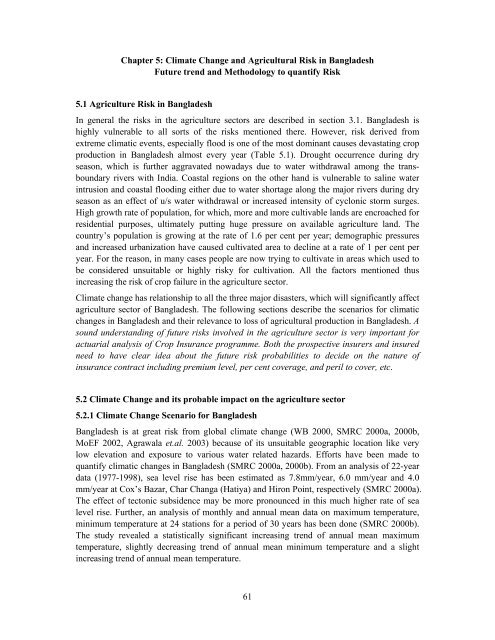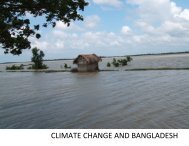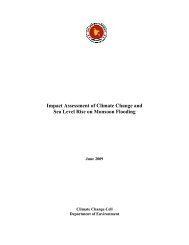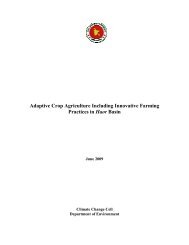Crop Insurance as a Risk Management Strategy in Bangladesh
Crop Insurance as a Risk Management Strategy in Bangladesh
Crop Insurance as a Risk Management Strategy in Bangladesh
Create successful ePaper yourself
Turn your PDF publications into a flip-book with our unique Google optimized e-Paper software.
Chapter 5: Climate Change and Agricultural <strong>Risk</strong> <strong>in</strong> <strong>Bangladesh</strong><br />
Future trend and Methodology to quantify <strong>Risk</strong><br />
5.1 Agriculture <strong>Risk</strong> <strong>in</strong> <strong>Bangladesh</strong><br />
In general the risks <strong>in</strong> the agriculture sectors are described <strong>in</strong> section 3.1. <strong>Bangladesh</strong> is<br />
highly vulnerable to all sorts of the risks mentioned there. However, risk derived from<br />
extreme climatic events, especially flood is one of the most dom<strong>in</strong>ant causes dev<strong>as</strong>tat<strong>in</strong>g crop<br />
production <strong>in</strong> <strong>Bangladesh</strong> almost every year (Table 5.1). Drought occurrence dur<strong>in</strong>g dry<br />
se<strong>as</strong>on, which is further aggravated nowadays due to water withdrawal among the transboundary<br />
rivers with India. Co<strong>as</strong>tal regions on the other hand is vulnerable to sal<strong>in</strong>e water<br />
<strong>in</strong>trusion and co<strong>as</strong>tal flood<strong>in</strong>g either due to water shortage along the major rivers dur<strong>in</strong>g dry<br />
se<strong>as</strong>on <strong>as</strong> an effect of u/s water withdrawal or <strong>in</strong>cre<strong>as</strong>ed <strong>in</strong>tensity of cyclonic storm surges.<br />
High growth rate of population, for which, more and more cultivable lands are encroached for<br />
residential purposes, ultimately putt<strong>in</strong>g huge pressure on available agriculture land. The<br />
country’s population is grow<strong>in</strong>g at the rate of 1.6 per cent per year; demographic pressures<br />
and <strong>in</strong>cre<strong>as</strong>ed urbanization have caused cultivated area to decl<strong>in</strong>e at a rate of 1 per cent per<br />
year. For the re<strong>as</strong>on, <strong>in</strong> many c<strong>as</strong>es people are now try<strong>in</strong>g to cultivate <strong>in</strong> are<strong>as</strong> which used to<br />
be considered unsuitable or highly risky for cultivation. All the factors mentioned thus<br />
<strong>in</strong>cre<strong>as</strong><strong>in</strong>g the risk of crop failure <strong>in</strong> the agriculture sector.<br />
Climate change h<strong>as</strong> relationship to all the three major dis<strong>as</strong>ters, which will significantly affect<br />
agriculture sector of <strong>Bangladesh</strong>. The follow<strong>in</strong>g sections describe the scenarios for climatic<br />
changes <strong>in</strong> <strong>Bangladesh</strong> and their relevance to loss of agricultural production <strong>in</strong> <strong>Bangladesh</strong>. A<br />
sound understand<strong>in</strong>g of future risks <strong>in</strong>volved <strong>in</strong> the agriculture sector is very important for<br />
actuarial analysis of <strong>Crop</strong> <strong>Insurance</strong> programme. Both the prospective <strong>in</strong>surers and <strong>in</strong>sured<br />
need to have clear idea about the future risk probabilities to decide on the nature of<br />
<strong>in</strong>surance contract <strong>in</strong>clud<strong>in</strong>g premium level, per cent coverage, and peril to cover, etc.<br />
5.2 Climate Change and its probable impact on the agriculture sector<br />
5.2.1 Climate Change Scenario for <strong>Bangladesh</strong><br />
<strong>Bangladesh</strong> is at great risk from global climate change (WB 2000, SMRC 2000a, 2000b,<br />
MoEF 2002, Agrawala et.al. 2003) because of its unsuitable geographic location like very<br />
low elevation and exposure to various water related hazards. Efforts have been made to<br />
quantify climatic changes <strong>in</strong> <strong>Bangladesh</strong> (SMRC 2000a, 2000b). From an analysis of 22-year<br />
data (1977-1998), sea level rise h<strong>as</strong> been estimated <strong>as</strong> 7.8mm/year, 6.0 mm/year and 4.0<br />
mm/year at Cox’s Bazar, Char Changa (Hatiya) and Hiron Po<strong>in</strong>t, respectively (SMRC 2000a).<br />
The effect of tectonic subsidence may be more pronounced <strong>in</strong> this much higher rate of sea<br />
level rise. Further, an analysis of monthly and annual mean data on maximum temperature,<br />
m<strong>in</strong>imum temperature at 24 stations for a period of 30 years h<strong>as</strong> been done (SMRC 2000b).<br />
The study revealed a statistically significant <strong>in</strong>cre<strong>as</strong><strong>in</strong>g trend of annual mean maximum<br />
temperature, slightly decre<strong>as</strong><strong>in</strong>g trend of annual mean m<strong>in</strong>imum temperature and a slight<br />
<strong>in</strong>cre<strong>as</strong><strong>in</strong>g trend of annual mean temperature.<br />
61





